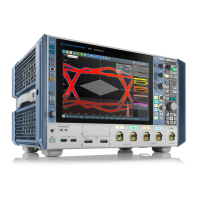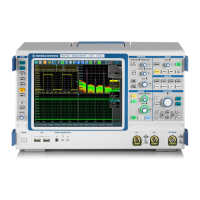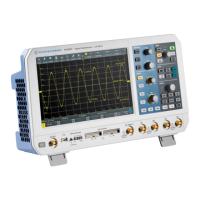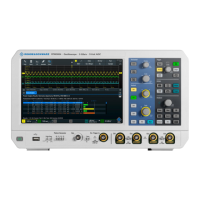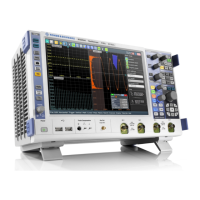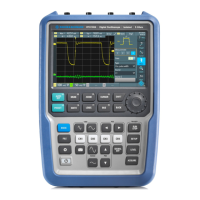Waveform analysis
R&S
®
RTE
300User Manual 1326.1032.02 ─ 20
"dx/dt"
Differentiates the source value with respect to the time value.
Not possible on envelope waveforms and waveforms with "Peak
detect" decimation.
"log(x)"
Calculates the logarithm of the source value based on 10.
"ln(x)"
Calculates the natural logarithm of the source value (based on e).
"ld(x)"
Calculates the binary logarithm of the source value (binary logarithm,
based on 2).
"Rescale"
Rescales the source values by a factor "a" and an offset "b": ax+b.
See also: "a / b" on page 300.
"FIR filter"
Finite impulse response filter - highpass, lowpass or bandpass filter
for a specified cut-off frequency and characteristic. See Chap-
ter 7.3.5.1, "FIR filter in the math setup", on page 310.
"Mag(FFT(x))"
Determines the magnitude of the FFT for the source values.
Noise reject
Only available for "Operator" = "dx/dt".
Sets the number of neighboring samples that are skipped for differentiation.
To suppress noise effects during differentiation, it can be useful not to consider two
directly neighboring points to calculate dx (x
n
-x
n-1
). Instead, some samples in-between
are skipped and a point a few samples further is used (e.g. x
n
-x
n-3
).
a / b
Defines the values for the "Rescale" function (ax+b).
"a"
Is the factor the signal source is multiplied with.
"b"
Is the offset of the signal source on the y-axis.
Enable math signal
Selects the upper or lower part of the waveform for mathematic calculation, or a combi-
nation of both.
The setting is relevant for waveforms with waveform arithmetic mode "Envelope" or
with "Peak detect" decimation. All mathematic operations - except for derivation - can
be applied to envelope waveforms and waveforms with "Peak detect" decimation.
Remote command:
CALCulate:MATH<m>:ENVSelection on page 1227
7.3.3.2 Defining a formula in the Basic editor
1. In the "Math" menu, select the "Setup" tab.
Alternatively, press the [MATH] key.
2. In the "Setup" tab, select the ""Basic"" tab.
3. Tap the "Source 1" and "Source 2" icons and select the signal sources to which the
math function is applied. For details on available signal sources, see "Source 1 / 2"
on page 299.
Mathematics
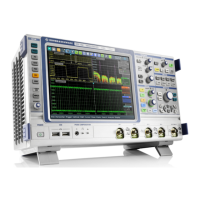
